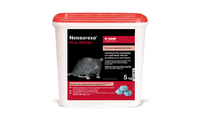BASF Professional & Specialty Solutions
The Pulse Baiting Technique
Making the Most of Single Feed Rodenticides
For anticoagulant baits there are 2 types of practical baiting techniques
- Surplus baiting
- Pulse baiting
Which type of baiting technique is employed depends on the active substance in the bait.
Surplus baiting technique; is used for all multi-feed anticoagulant rodenticide baits. That is all baits for which the rat or mouse is expected to eat a lethal amount of that bait only after feeding multiple times on the bait. Therefore, to facilitate this multiple feeding requires a surplus amount of the bait is always available at each and every bait point. So, bait point sizes need to be larger, typically up to 200g, and bait replenishment needs to be undertaken more frequently to ensure that a surplus amount of bait is always in place. Usually 8 visits are required over a three- week period to gain control.
Multiple feeds baits are those that contain one of the following actives
- any First Generation Anticoagulants FGARs (e.g. coumatetralyl, cholorophacinone, warfarin)
- the Second Generation Anticoagulants (SGARs) bromadialone, difenacoum and difethialone.
Pulse baiting technique is used for all single-feed rodenticide baits. That is, only for baits where the bait is sufficiently potent that a rat or mouse can eat a lethal amount of that bait in just one single feed. The single feed baits are those that contain as their active
- the SGARs that are the most potent to rats and mice, that is flocoumafen (Storm Secure and Storm Ultra Secure) or brodifacoum.
In all other areas of treatment, both techniques utilise the CRRU code of practice.
Advantages of Pulse baiting
1. Less bait required per bait point. Due to the potency of the single feed baits in rats and mice, pulse baiting requires a lesser amount of bait to be placed at each point compared to the surplus baiting technique. Particularly for rats. Examples of bait point sizes, from product labels, are shown in Table 1. Less bait per bait point means
- less bait placed in the environment
- less bait waste
- less bait required to be purchased per treatment.
This is demonstrated in Figure 1, which shows bait required and time to control using the two different baiting techniques.
Table 1: Bait point sizes.
| Baiting technique |
bait | Bait point size, g Rats |
Bait point size, g Mice |
| Multi-feed bait | Coumatetralyl | 200 | ---- |
| Multi-feed bait | Bromadiolone | Up to 200 | Up to 40 |
| Multi-feed bait | Difenacoum | Up to 200 | Up to 40 |
| Multi-feed bait | Difethialone | Up to 200 | Up to 50 |
| Single feed | Storm® Secure | 40-60 | 20 |
| Single feed | Neosorexa® Plus Blocks | 50-75 | 25 |
Figure 1. Bait used to control Brown rat infestations with a multiple feed anticoagulant using surplus baiting and Neosorexa® Plus Blocks using pulse baiting.

2. Fewer visits to replenish the bait required. As the requirement for surplus baiting is that bait must always be available at each bait point, the number of visits required to replenish the bait will be more frequent than for pulse baiting. Particularly in a heavier infestation.
However, when using pulse baiting it is expected that there may be times, when there is no bait at some of the bait points. Particularly in the early days of the treatment and particularly with a palatable bait such as Neosorexa® Plus Blocks. This is OK and is factored into the pulse baiting technique, so the pest controller does not have to continually replenish the bait beyond the label recommended pulses.
Typical Neosorexa® Plus Blocks baiting programme
- Pulse 1 day 1.
- The first rodents (dominants) feed on the bait and start to feel the toxic effects on or around days 3-4.
- Pulse 2, day 4.
- Targets other individuals (sub-dominants) in the infestation, which then start to feel the toxic effects on or around days 7 -8
- Pulse 3, day 7.
- Targets non-dominants in the infestation, which then start to feel the toxic effects on or around days 10-11
- Pulse 4, day 14.
- Targets the remaining infestation. This pulse may not be required as the infestation may be controlled.
- Pulse 5, day 21.
- Targets the remaining infestation. This pulse may not be required. This pulse may not be required as the infestation may be controlled.
- Fewer bait replenishments with pulse baiting means
- Saving on time
- Saving on worrying if there is sufficient bait at each bait point
3. Due to the single feeds being more potent, particularly in rats, control of the infestation may be quicker with the single feed baits. As indicated in the last row of Figure 1.
Therefore, by pulse-baiting professional pest controllers can save substantial amounts of time and money by utilising single feed rodenticides like Storm® Secure and Neosorexa® Plus Blocks in the most time and cost efficient way possible.
Related Product
Information: Use biocide products carefully. Always read the label and product information before use.
